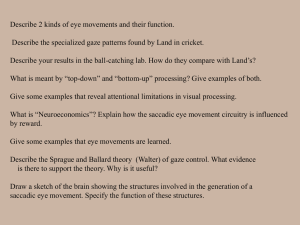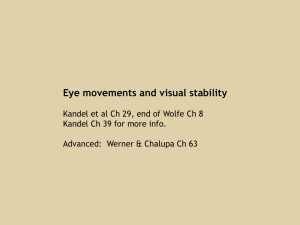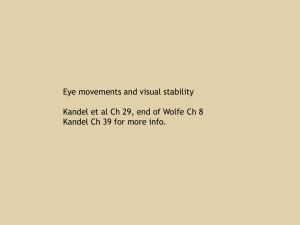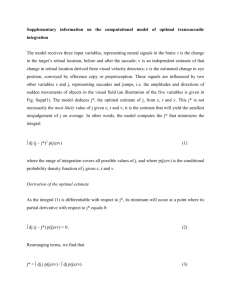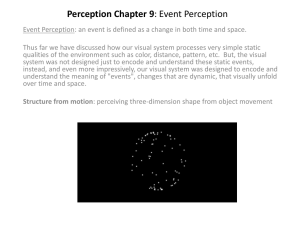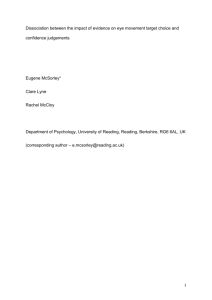Detecting Affect During Writing
advertisement
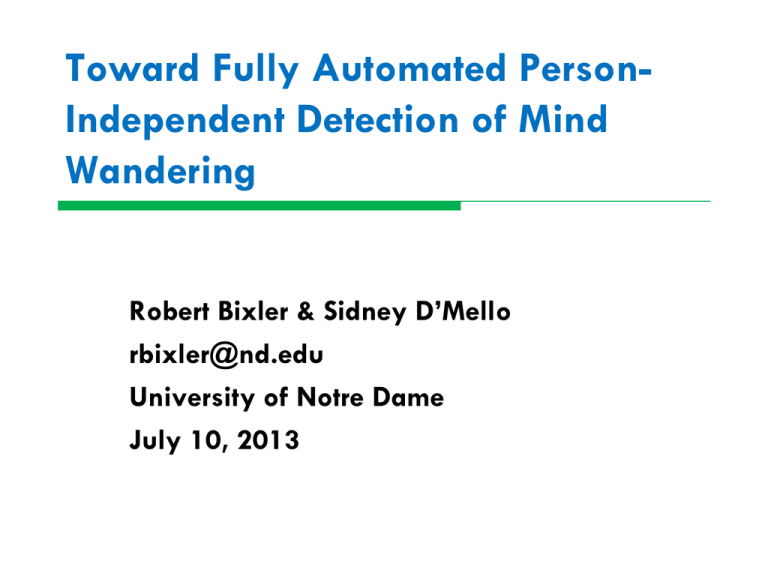
Toward Fully Automated PersonIndependent Detection of Mind Wandering Robert Bixler & Sidney D’Mello rbixler@nd.edu University of Notre Dame July 10, 2013 mind wandering indicates waning attention occurs frequently 20-40% of the time decreases performance comprehension memory solutions proactive mindfulness training tailoring learning environment Mrazek (2013) Kopp, Bixler, D’Mello (2014) reactive mind wandering detection our goal is to detect mind wandering related work – attention Attention and Selection in Online Choice Tasks Multi-mode Saliency Dynamics Model for Analyzing Gaze and Attention Navalpakkam et al. (2012) Yonetani, Kawashima, and Matsuyama (2012) distinct from mind wandering mind wandering detection neural activity physiology acoustic/prosodic eye movements neural activity Experience Sampling During fMRI Reveals Default Network and Executive System Contributions to Mind Wandering Christoff et al. (2009) physiology Automated Physiological-Based Detection of Mind Wandering during Learning Blanchard, Bixler, D’Mello (2014) acoustic-prosodic In the Zone: Towards Detecting Student Zoning Out Using Supervised Machine Learning Drummond and Litman (2010) eye movements mindless reading mindful reading research questions 1. can mind wandering be detected from eye gaze data? 2. which features are most useful for detecting mind wandering? data collection 4 texts on research methods self-paced page-by-page 30-40 minutes difficulty and value auditory probes tobii tx300 9 per text inserted psuedorandomly (4-12s) type of report end-of-page within-page total yes 209 1278 1487 no 651 2839 3490 total 860 4117 4977 data analysis 1. compute fixations OGAMA (Open Gaze and Mouse Analyzer) (Voßkühler et al. 2008) 2. compute features 3. build supervised machine learning models features global local context global features eye movements fixation duration saccade duration saccade length fixation dispersion reading depth fixation/saccade ratio local features reading patterns word length hypernym depth number of synonyms frequency fixation type regression first pass single gaze no word context features positional timing previous page times since session start since text start since page start average previous page to average ratio task difficulty value supervised machine learning parameters window size (4, 8, or 12) minimum number of fixations (5, 1/s, 2/s, or 3/s) outlier treatment (trimmed, winsorized, none) feature type (global, local, context, combined) downsampling feature selection classifiers (20 standard from weka) leave-several-subjects-out cross validation (66:34 split) 1. can mind wandering be detected using eye gaze data? best model kappas 0.3 0.25 kappa 0.2 0.15 0.1 0.05 0 End-of-page Within-page report type 1. can mind wandering be detected using eye gaze data? 75 70 accuracy % 65 60 Accuracy 55 Expected Accuracy 50 45 40 End-of-page Within-page 1. can mind wandering be detected using eye gaze data? confusion matrices end-of-page actual classified response response within-page prior actual classified response response prior yes no yes .54 .46 .23 yes no yes .61 .39 .36 no .23 .77 .77 no .42 .58 .64 2. which features are most useful for detecting mind wandering? kappa average kappa values across feature types 0.3 Global 0.2 Local Context 0.1 0 End-of-page Within-page report type Global + Local + Context 2. which features are most useful for detecting mind wandering? rank end-of-page within-page 1 previous value saccade length max 2 previous difficulty saccade length median 3 difficulty fixation duration ratio 4 value saccade length range 5 saccade length max saccade length mean 6 saccade length range saccade length skew 7 page number fixation duration median 8 saccade length sd fixation duration mean 9 saccade length mean saccade duration mean 10 saccade length skew saccade duration min summary mind wandering detection is possible kappas of .28 to .17 end-of-page models performed better global features were best exception: context features highest ranked for end-of-page enhanced feature set global pupil diameter blink frequency saccade angle local cross-line saccades end-of-clause fixations enhanced feature set 0.3 kappa 0.25 Original Enhanced 0.2 0.15 0.1 End-of-page Within-page predictive validity mw rate end-of-page predicted actual (model) post transfer knowledge learning -.556 -.248 -.415 -.266 actual (all data) -.239 -.207 within-page predicted actual (model) actual (all data) -.496 -.095 -.255 -.431 -.090 -.207 self-caught mind wandering self-caught vs. probe caught 0.35 0.3 kappa 0.25 0.2 0.15 0.1 0.05 0 End-of-page Within-page report type Self-Caught what does mind wandering look like? saccades slower shorter more frequent blinks larger pupil diameters limitations eye tracker cost population validity self-report classification accuracy future work multiple modalities different types of mind wandering mind wandering intervention acknowledgements Blair Lehman Art Graesser Jennifer Neale Nigel Bosch Caitlin Mills questions ?
